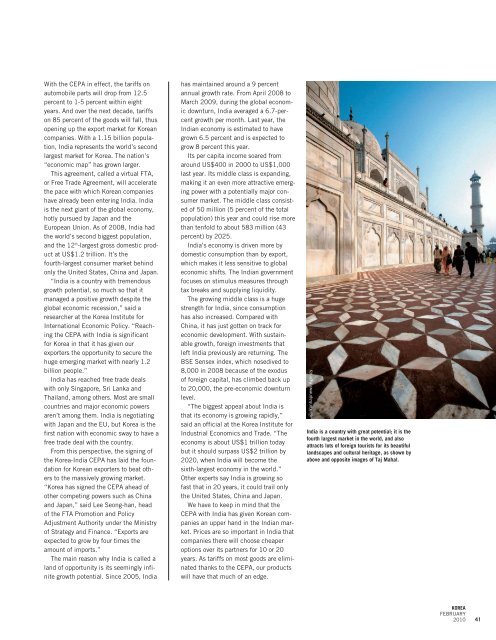www.korea.net
KOREAN MOVIES - Korea.net
KOREAN MOVIES - Korea.net
- No tags were found...
Create successful ePaper yourself
Turn your PDF publications into a flip-book with our unique Google optimized e-Paper software.
With the CEPA in effect, the tariffs on<br />
automobile parts will drop from 12.5<br />
percent to 1-5 percent within eight<br />
years. And over the next decade, tariffs<br />
on 85 percent of the goods will fall, thus<br />
opening up the export market for Korean<br />
companies. With a 1.15 billion population,<br />
India represents the world’s second<br />
largest market for Korea. The nation’s<br />
“economic map” has grown larger.<br />
This agreement, called a virtual FTA,<br />
or Free Trade Agreement, will accelerate<br />
the pace with which Korean companies<br />
have already been entering India. India<br />
is the next giant of the global economy,<br />
hotly pursued by Japan and the<br />
European Union. As of 2008, India had<br />
the world’s second biggest population,<br />
and the 12 th -largest gross domestic product<br />
at US$1.2 trillion. It’s the<br />
fourth-largest consumer market behind<br />
only the United States, China and Japan.<br />
“India is a country with tremendous<br />
growth potential, so much so that it<br />
managed a positive growth despite the<br />
global economic recession,” said a<br />
researcher at the Korea Institute for<br />
International Economic Policy. “Reaching<br />
the CEPA with India is significant<br />
for Korea in that it has given our<br />
exporters the opportunity to secure the<br />
huge emerging market with nearly 1.2<br />
billion people.”<br />
India has reached free trade deals<br />
with only Singapore, Sri Lanka and<br />
Thailand, among others. Most are small<br />
countries and major economic powers<br />
aren’t among them. India is negotiating<br />
with Japan and the EU, but Korea is the<br />
first nation with economic sway to have a<br />
free trade deal with the country.<br />
From this perspective, the signing of<br />
the Korea-India CEPA has laid the foundation<br />
for Korean exporters to beat others<br />
to the massively growing market.<br />
“Korea has signed the CEPA ahead of<br />
other competing powers such as China<br />
and Japan,” said Lee Seong-han, head<br />
of the FTA Promotion and Policy<br />
Adjustment Authority under the Ministry<br />
of Strategy and Finance. “Exports are<br />
expected to grow by four times the<br />
amount of imports.”<br />
The main reason why India is called a<br />
land of opportunity is its seemingly infinite<br />
growth potential. Since 2005, India<br />
has maintained around a 9 percent<br />
annual growth rate. From April 2008 to<br />
March 2009, during the global economic<br />
downturn, India averaged a 6.7-percent<br />
growth per month. Last year, the<br />
Indian economy is estimated to have<br />
grown 6.5 percent and is expected to<br />
grow 8 percent this year.<br />
Its per capita income soared from<br />
around US$400 in 2000 to US$1,000<br />
last year. Its middle class is expanding,<br />
making it an even more attractive emerging<br />
power with a potentially major consumer<br />
market. The middle class consisted<br />
of 50 million (5 percent of the total<br />
population) this year and could rise more<br />
than tenfold to about 583 million (43<br />
percent) by 2025.<br />
India’s economy is driven more by<br />
domestic consumption than by export,<br />
which makes it less sensitive to global<br />
economic shifts. The Indian government<br />
focuses on stimulus measures through<br />
tax breaks and supplying liquidity.<br />
The growing middle class is a huge<br />
strength for India, since consumption<br />
has also increased. Compared with<br />
China, it has just gotten on track for<br />
economic development. With sustainable<br />
growth, foreign investments that<br />
left India previously are returning. The<br />
BSE Sensex index, which nosedived to<br />
8,000 in 2008 because of the exodus<br />
of foreign capital, has climbed back up<br />
to 20,000, the pre-economic downturn<br />
level.<br />
“The biggest appeal about India is<br />
that its economy is growing rapidly,”<br />
said an official at the Korea Institute for<br />
Industrial Economics and Trade. “The<br />
economy is about US$1 trillion today<br />
but it should surpass US$2 trillion by<br />
2020, when India will become the<br />
sixth-largest economy in the world.”<br />
Other experts say India is growing so<br />
fast that in 20 years, it could trail only<br />
the United States, China and Japan.<br />
We have to keep in mind that the<br />
CEPA with India has given Korean companies<br />
an upper hand in the Indian market.<br />
Prices are so important in India that<br />
companies there will choose cheaper<br />
options over its partners for 10 or 20<br />
years. As tariffs on most goods are eliminated<br />
thanks to the CEPA, our products<br />
will have that much of an edge.<br />
Yonhapnews Agency<br />
India is a country with great potential; it is the<br />
fourth largest market in the world, and also<br />
attracts lots of foreign tourists for its beautiful<br />
landscapes and cultural heritage, as shown by<br />
above and opposite images of Taj Mahal.<br />
KOREA<br />
FEBRUARY<br />
2010<br />
41
















